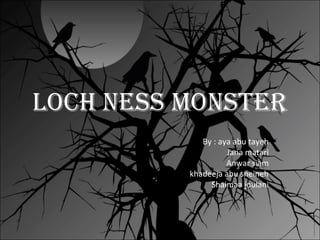
finding nessie
- 1. Loch ness monster By : aya abu tayeh Jana matari Anwar siam khadeeja abu sneineh Shaimaa joulani
- 2. • The Loch Ness Monster is a cryptid, reputedly a large unknown animal that inhabits Loch Ness in the Scottish Highlands. It is similar to other supposed lake monsters in Scotland and elsewhere, though its description varies from one account to the next.
- 5. St. ColumbaSt. Columba was the first person who saw Nessie, in 565.
- 6. Popular interest and belief in the animal's existence has varied since it was first brought to the world's attention in 1933. Evidence of its existence is anecdotal, with minimal and much-disputed photographic material and sonar readings.
- 7. The most common speculation among believers is that the creature represents a line of long-surviving plesiosaurs.
- 8. The scientific community regards the Loch Ness Monster as a modern- day myth, and explains sightings as including misidentifications of more mundane objects, outright hoaxes, and wishful thinking. Despite this, it remains one of the most famous examples of cyptozoology. The legendary monster has been affectionately referred to by the nickname Nessie.
- 9. Hugh Gray’s Photograph(1933) • On 12 November 1933, Hugh Gray was walking along the loch after church when he spotted a large creature rising up from the lake. Gray took several pictures of it, but only one of them showed up after they were developed.
- 10. "Surgeon's Photograph" (1934) The "Surgeon's Photograph" purported to be the first photo of a "head and neck“. Dr. Wilson claimed he was looking at the loch when he saw the monster, so grabbed his camera and snapped five photos.
- 11. There have been some expeditions, sonar studies, submersible investigations... in the Loch Ness to find Nessie.
- 13. However, many people say that there isn't a monster in Loch Ness.
- 14. Misidentification of inaniMate objects or effects • Trees • In 1933 the Daily mirror showed a picture with the following caption 'This queerly-shaped tree-trunk, washed ashore at Foyers may, it is thought, be responsible for the reported appearance of a "Monster”’. • Optical effects • Wind conditions can give a slightly choppy and thus matte appearance to the water, with occasional calm patches appearing as dark ovals (reflecting the mountains) from the shore, which can appear as humps to visitors unfamiliar with the loch.
- 15. The people who don't believe that a monster lives in the loch say... The pictures and videos are false. If there is only one monster, the one St. Columba saw 1400 years ago, would have died by now. If there are many monsters: The loch has not got enough food to feed a group of large animals. How do they all keep from being
- 16. After these explanations... Do you think there is a monster in Loch Ness or not?